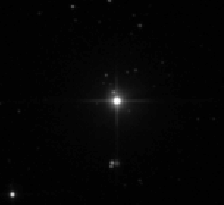AU Microscopii
| Observation data Epoch J2000 Equinox J2000 |
|
|---|---|
| Constellation | Microscopium |
| Right ascension | 20h 45m 09.53147s |
| Declination | –31° 20′ 27.2425″ |
| Apparent magnitude (V) | 8.73 |
| Characteristics | |
| Spectral type | M1 Ve |
| U−B color index | 1.01 |
| B−V color index | 1.45 |
| Variable type | Flare star |
| Astrometry | |
| Radial velocity (Rv) | –6.0 km/s |
| Proper motion (μ) |
RA: +279.96 mas/yr Dec.: -360.61 mas/yr |
| Parallax (π) | 100.91 ± 1.06mas |
| Distance | 32.3 ± 0.3 ly (9.9 ± 0.1 pc) |
| Absolute magnitude (MV) | 8.61 |
| Details | |
| Mass | 0.31 M☉ |
| Radius | 0.84 R☉ |
| Luminosity | 0.09 L☉ |
| Temperature | 3,500 ± 100 K |
| Rotational velocity (v sin i) | 9.3 km/s |
| Age | 12 ± 2 Myr |
| Other designations | |
| Database references | |
| SIMBAD | data |
| ARICNS | data |
AU Microscopii (AU Mic) is a small star located 32.3 light-years (9.9 parsecs) away – about 8 times as far as the closest star after the Sun. The apparent visual magnitude of AU Microscopii is 8.73, which is too dim to be seen with the naked eye. It was given this designation because it is in the southern constellation Microscopium and is a variable star. Like β Pictoris, AU Microscopii has a circumstellar disk of dust known as a debris disk.
AU Mic is a young star at only 12 million years old; less than 1% of the age of the Sun. With a stellar classification of M1 Ve, it is red dwarf star with a physical radius of 60% that of the Sun. Despite being more than half the Sun's mass, it is radiating only 9% as much luminosity as the Sun. This energy is being emitted from the star's outer atmosphere at an effective temperature of 3,730 K, giving it the cool orange-red hued glow of an M-type star. AU Microscopii is a member of the β Pictoris moving group. AU Microscopii may be gravitationally bound to the binary star system AT Microscopii.
AU Microscopii has been observed in every part of the electromagnetic spectrum from radio to X-ray and is known to undergo flaring activity at all these wavelengths. Its flaring behaviour was first identified in 1973. Underlying these random outbreaks is a nearly sinusoidal variation in its brightness with a period of 4.865 days. The amplitude of this variation changes slowly with time. The V band brightness variation was approximately 0.3 magnitudes in 1971; by 1980 it was merely 0.1 magnitudes.
...
Wikipedia

